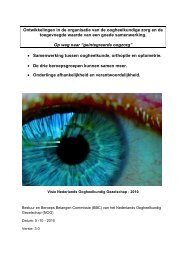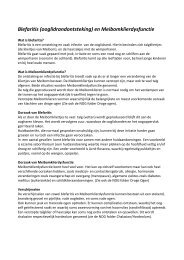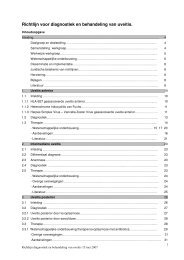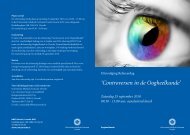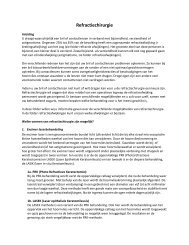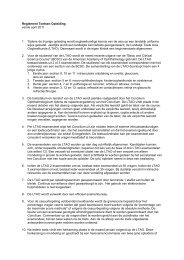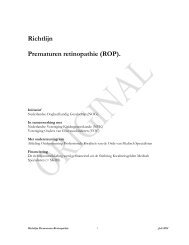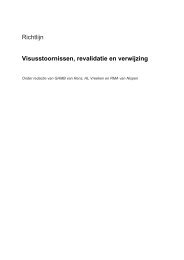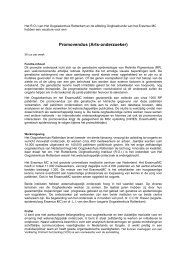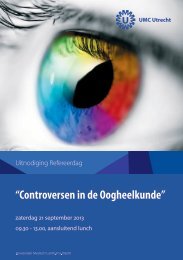terminology and guidelines for glaucoma ii - Kwaliteitskoepel
terminology and guidelines for glaucoma ii - Kwaliteitskoepel
terminology and guidelines for glaucoma ii - Kwaliteitskoepel
You also want an ePaper? Increase the reach of your titles
YUMPU automatically turns print PDFs into web optimized ePapers that Google loves.
HODAPP CLASSIFICATION 31<br />
EARLY GLAUCOMATOUS LOSS<br />
a) MD > - 6 dB<br />
b) Fewer than 18 points depressed below the 5% probability level <strong>and</strong> fewer than 10 points below the p < 1% level<br />
c) No point in the central 5 degrees with a sensitivity of less than 15 dB<br />
MODERATE GLAUCOMATOUS LOSS<br />
a) -6 > MD > -12 dB<br />
b) Fewer than 37 points depressed below the 5% probability level <strong>and</strong> fewer than 20 points below the p < 1% level<br />
c) No absolute deficit (0 dB) in the 5 central degrees<br />
d) Only one hemifield with sensitivity of < 15 dB in the 5 central degrees<br />
ADVANCED GLAUCOMATOUS LOSS<br />
a) MD < -12 dB<br />
b) More than 37 points depressed below the 5% probability level or more than 20 points below the p < 1% level<br />
c) Absolute deficit ( 0 dB) in the 5 central degrees<br />
d) Sensitivity < 15 dB in the 5 central degrees in both hemifields<br />
1.4.5 - WORSENING OF THE VISUAL FIELD<br />
Looking <strong>for</strong> visual field progression is the most important part of clinical management in chronic <strong>glaucoma</strong> because<br />
this is the outcome that affects the patients quality of life. Changes in the visual field will make the Physician consider<br />
a change in clinical management The identification of visual field progression requires a series of fields, usually more<br />
than three, <strong>and</strong> often 5 or 6. Diagnosing visual field progession on a shorter visual field series is risky, because of the<br />
inherent variability in patient responses. The exception would be a dramatic change that was associated with corresponding<br />
symptoms suggesting visual loss <strong>and</strong> confirmed by unquestionable changes in ONH/RNFL. In many instances<br />
of such sudden change, the cause will not be <strong>glaucoma</strong>, but either vascular in origin, or due to changes in the visual<br />
pathways.<br />
Recent Treatment/No Treatment trials (see Introduction) have shown that <strong>glaucoma</strong>tous field progression is usually<br />
slow, <strong>and</strong> that it will rarely be detected within one year of followup, even with a strict test/retest regime. In clinical practice<br />
there will be an individual approach, with stricter follow up being indicated in cases with advanced disease or with<br />
VF defects close to fixation. A practical scheme is to per<strong>for</strong>m 2-3 tests that ‘train’ the patient, <strong>and</strong> provide mean values<br />
<strong>for</strong> a baseline, <strong>and</strong> then to repeat testing twice a year. A clinical routine that involves less frequent testing will reduce<br />
the chances of identifying change.<br />
Reduced sensitivity in a cluster of test points on the same hemifield, <strong>and</strong> outside the periphery by >=5db, or a single<br />
test point by > 10 db needs confirmation. This confirmation needs to be obtained on 2 subsequent field tests be<strong>for</strong>e<br />
deemed a permanent change.<br />
As an example, when using the Glaucoma Change Probability Maps in the Humphrey perimeter, at least three points<br />
flagged as significantly progressing that occur in the same location in three consecutive examinations can be used to<br />
define ‘confirmed’ <strong>glaucoma</strong>tous field progression; the same pattern occurring in two consecutive fields can be used to<br />
denote ‘tentative’ field progression.<br />
Ch. 1 - 29 EGS



